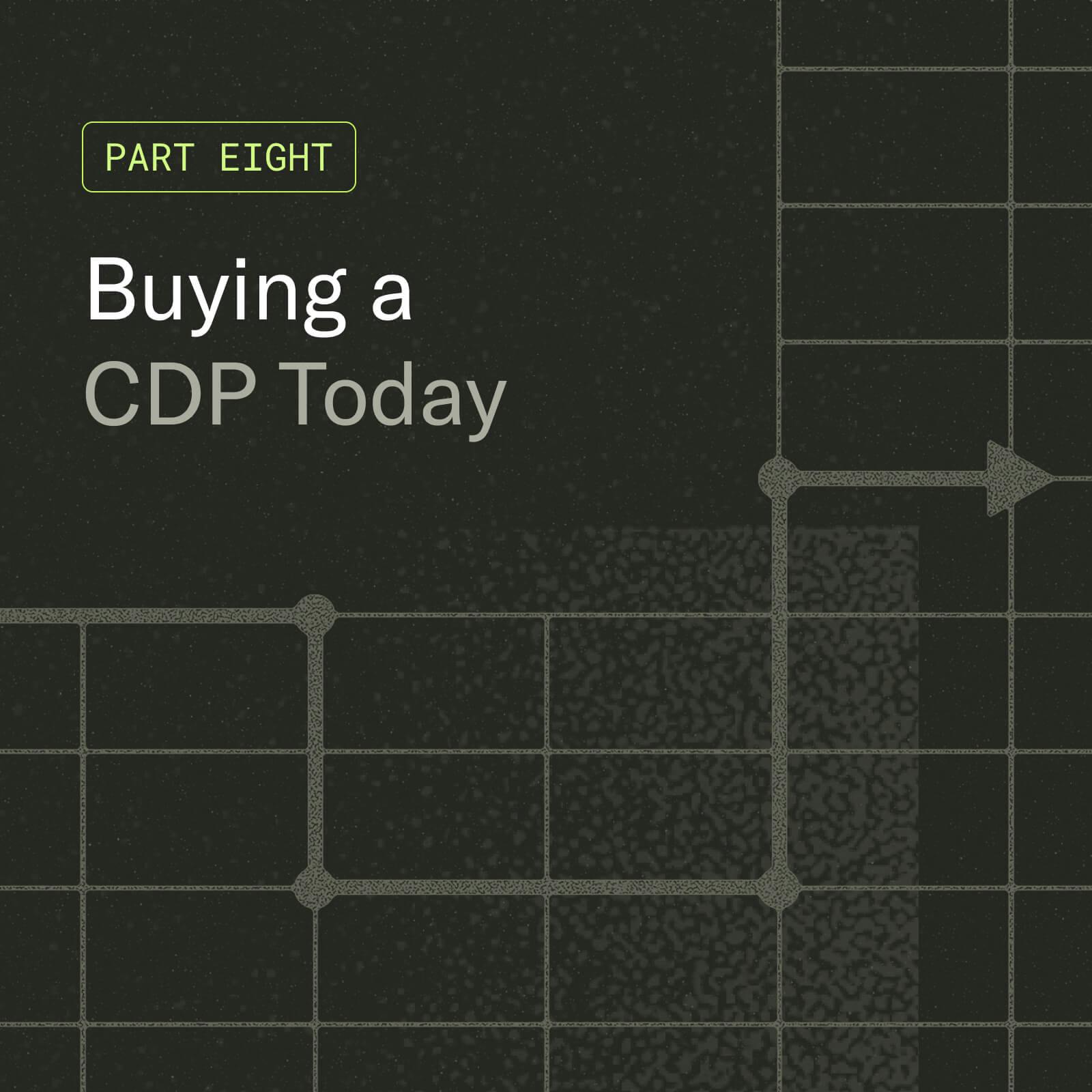Customer Data Platform implementation guide
ROI of a Customer Data Platform: How to identify the five value points for investing in a CDP.

Marketers always talk about data being a “core asset,” but rarely treat it that way. When it comes to securing, measuring, and maximizing the financial value of their data investments, even the most data-driven marketers, ironically, overlook the basic tenets of financial planning and analysis.
This series is designed to help you build a better business case for data management, and understand the levers with which to measure and optimize the ROI of the investments you’ve already made.
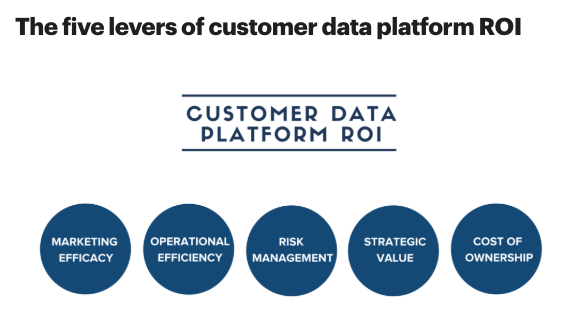
Whenever deciding how to allocate scarce resources from one project to the next, it’s not only the direct performance lift you should be thinking about. Factors such as time, risk and the cost of capital are also critically important in making a fully informed decision.
Similarly, to assess the business impact of any data infrastructure investment, and specifically a Customer Data Platform (CDP), you should organize your business case into the following five areas:
- Marketing effectiveness: The incremental value associated with creating “more bang for the same buck”
- Marketing operations cost avoidance: The cost savings associated with operating more efficiently
- Risk reduction: The value associated with reducing business, technology, and regulatory risk
- Strategic value: The value associated with creating barriers to entry based on customer data advantage, which in turn drives profit margin
- Total cost of ownership: The total cost of the CDP initiative, including software license, setup, services, training, and operations
Each of these levers represents an opportunity to optimize value return to the business.
I. Marketing Efficacy
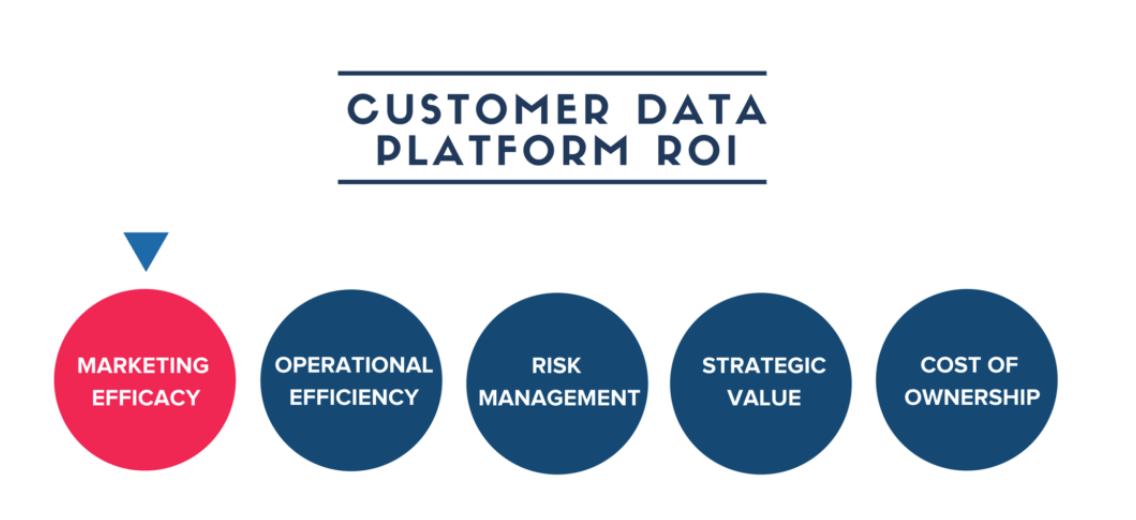
The first thing that marketers need to ask themselves when considering a new CDP is how it could provide value in terms of efficacy. Marketers know that personalization can provide 5-8x the ROI on marketing spend, and lift sales by 20%.
Data connectivity, unification, accessibility, and control—for which CDPs provide a partial, technology-enabled solution—are a necessary but not sufficient part of getting personalization right. So how do you value their contribution to performance lift?
My recommendation is to break their contribution down into three areas:
Speed
Personalization data has diminishing value to marketers over time. Out-of-date segments result in inaccurate targeting, where messages are delivered to people that no longer fit the target parameters and aren’t delivered to people that should be targeted. CDPs let you climb the time-value curve, unlocking opportunities beyond what would ever be possible with manual methods for segmenting and connecting data.
Questions to ask: Is your data time sensitive? What opportunities can you unlock with faster data?
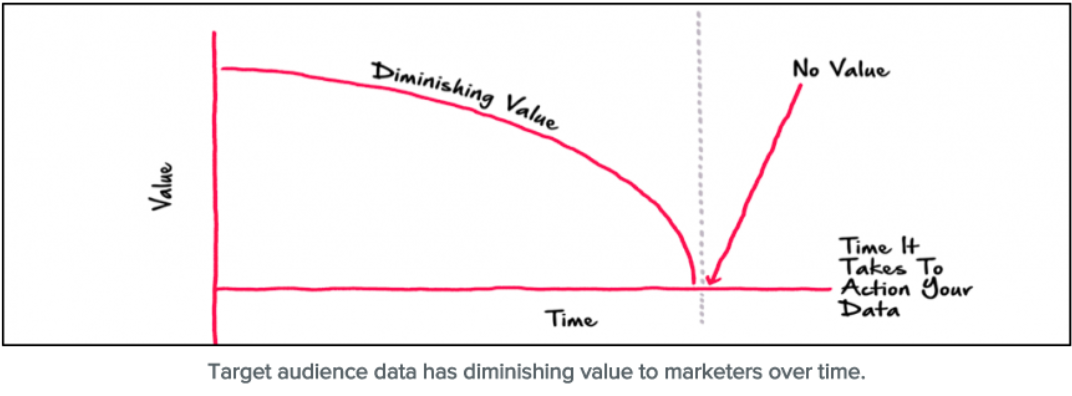
Orchestration
Beyond feeding your targeted campaigns with recent and relevant data, CDPs can also provide cross-channel lift. Orchestrated messaging across advertising and marketing channels, for example, has been shown time and again to yield better results than doing either one isolation. According to one study commissioned by Facebook and Salesforce, a customer that coordinated its Facebook advertising with email increased reach by 77% and saw a 22% increase in purchase intent for customers exposed to messages in both email and ads.
Questions to ask: What channels or customer journey stages in your marketing mix could be better coordinated? What would be the lift* from better orchestration? (*note: you might try answering this question by conducting a manual test first)
Context
Last but not least, there’s the value of personalizing advertising and marketing messages based on the full customer context that you get with a CDP. For example, one CDP vendor describes here how a retailer thought their best customers were those who purchased multiple times from their website. Only after joining the online data with in-store purchase records did they realize that those same customers were returning many items to the store, diminishing their lifetime value as customers.
This is not a new problem in database marketing. In fact, I recall a distinguished direct marketer once telling his secret to higher yielding campaigns was removing dead people from his company’s mailing list. Yet, with the customer journey now bouncing across so more channels and devices today than even, with no single channel coming even close to approximating the totality of the experience (and some engagement points, like mobile, being extremely personal and potentially intrusive), it’s essential that companies’ targeting and personalization efforts are rooted in a holistic, up-to-date customer view at all times.
Questions to ask: What are your current blindspots when it comes to personalization? What opportunities might you be able to unlock with better context?
II. Operational efficiency
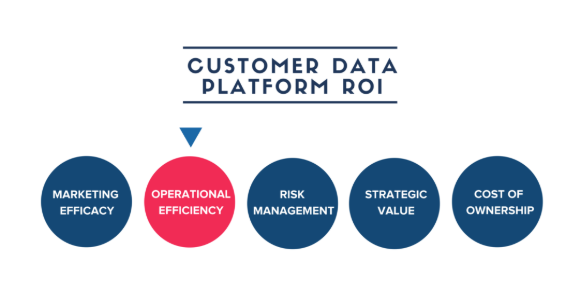
The second customer data platform business case driver, operational efficiency, focuses on the cost saving aspects of a CDP (“same bang for fewer bucks”). Depending on the CDP you are evaluating, and how it is implemented, you may be able to find cost savings through automation in one if not all three areas of these areas:
Data integration efficiencies
Most advertising and marketing technology platforms—even SaaS-based ones—require a considerable upfront investment to get them working properly. These investments pile up when you consider that the average large company has 22 martech platforms in their stack, and eight more in the process of being deployed.
In fact, these numbers (from Gartner) probably understate the number of tools in the mobile space, where implementation is even more complicated. Native apps are software products consisting of independent elements, so data collection requires a skilled engineer to define what user interactions should be captured for each app element. Because this happens on a per-SDK basis, there can be hundreds of in-app events that need to be manually tagged and run through a QA process. CDPs with the right prebuilt connectors can provide a fast path to integration, reducing setup costs by as much as 90% and saving literally thousands of hours of engineering time. As another example, SeatGeek, the event ticket search engine, found that using a CDP as the foundation for their marketing stack decreased the time for new vendor integration from several weeks to just under three days.
Furthermore, every integration (mobile, marketing cloud, or otherwise) requires constant maintenance, which carries its own resource cost. Partner APIs change all the time and so without a CDP, you are susceptible to spending time and energy on seemingly endless integration efforts, rather than core development and marketing.
Questions to ask: How many integrations are you currently maintaining, and how many new platforms do you anticipate implementing over the coming 12-18 months? What is the dollar value of setup and maintenance costs that could be avoided with the right CDP?
Marketing ops efficiencies
A typical people-based marketing workflow could include a marketer defining a segmentation strategy (e.g., “give me everyone who has attended one of our events and engaged with 2+ of our digital properties in the past 12 months”), sending it to engineering for processing, then uploading the resulting audience to separate platforms. This process is repeated constantly as new platforms are tested and to ensure audiences stay up to date. Similarly, time-intensive processes are performed whenever the business wants to perform bespoke customer journey analyses–and we have not even begun talking about the kind of data cleanup needed for more complex predictive and prescriptive analytics. Fortunately, much of the back-and-forth around these queries can be automated with a CDP, saving the company significant resources as Stash Invest’s Annica Lin discovered:
Questions to ask: How much time do your marketing, analytics, and data operations teams spend building user lists each month? What is the dollar value of the time that could be saved by automating these activities?
Media cost avoidance
Suppression lists have long been a popular tactic among direct marketers because they can help to minimize exposure fatigue and improve overall customer experience. With many paid media channels now offering identity-based advertising, they are also becoming a favorite tactic for media buyers looking to increase ROI by eliminating spend on wasted impressions. For example, SeatGeek found that on Snapchat alone 30 to 40% of their app install campaign impressions were being wasted on people who already had the app! Because they had a CDP, they were able to flip a switch and tell Snapchat to stop sending the app install campaign to those users, and keep Snapchat constantly informed as new users convert to unenroll them from the campaign as well.
Questions to ask: How much are you spending on paid media that could be saved with better suppression list management and syncing?
III. Risk management
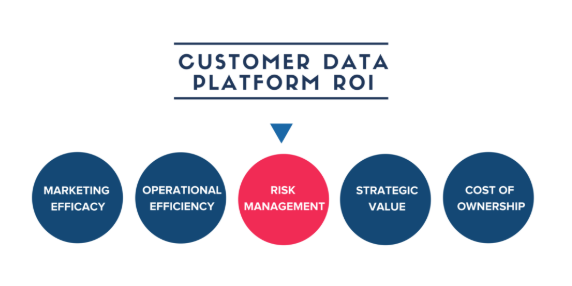
More and more, marketing investments involve a considerable amount of risk. On one level, they have become now more capital intensive, with high upfront cost investments in technology amortized, one hopes, over considerable lengths of time (much longer than a single “campaign”). At the same time, many of these investments carry with them not only technology and financing risk, but also no small amount of regulatory compliance risk.
How CDPs help mitigate risk
Uncertainty increases the required “breakeven” point for investments, including marketing investments, essentially raising the bar. Customer data platforms, by mitigating risk, lower that bar down somewhat.
Insurance policies operate under much the same principle. By eliminating, or at least lowering, your downside risk, they create a measurable value that you as a consumer are willing to pay for.
Investing in a CDP can create an insurance policy of sorts in three areas, reducing platform risk (data dependency), payback risk (time to value), and regulatory risk (ensuring your ecosystem is compliant).
Platform risk
While most SaaS investments bill themselves as a subscription service, they often require significant upfront investment in integration and training, and, then—should you cancel—it’s not always easy to carry your data with you to the next provider.
What’s more, any partner you work with can experience data outages, whose effects can be devastating.
CDPs can help you mitigate the risks of platform lock-in, data loss, and obsolescence by storing a copy of your data that you can “replay” to new vendors, or the same vendor, at any time. Using a CDP puts your data under your control so that you’re not at the mercy of third-parties.
Questions to ask: What is the likelihood of a vendor you are using having a data outage, or that you will need to swap out vendors in the future? What would be the consequences to you if that happened?
Reduced time to value
By eliminating integration friction, customer data platforms are able to accelerate time to value across an entire portfolio of martech initiatives. The net result is to reduce the payback window of your marketing campaigns and technology investments. Shorter payback windows, for the same expenditure, equates to less risk.
Questions to ask: What is your current average payback period on martech investments? What is the risk premium you associate with long vs short implementation windows?
Reduced compliance risk
Data security and privacy is a concern at the top of everyone’s mind, whether you are a private citizen, a brand collecting first-party data, a vendor, or a governmental body. More than ever before, your customer data needs to be secure and reliable from end to end. Data breaches are an unfortunate reality as the recent Uber, Yahoo, and Equifax breaches show, and they can cost you the consumer trust you have worked so hard to build.
Minimizing the risk of data leakage needs to be a priority for brands and for marketers, which means they need to know that every part of their ecosystem is compliant with the most up-to-date security measures. But, with the sheer number of vendors that make up a martech stack, that’s a tall order. Fortunately, the right CDP can provide you with filters and controls to track and govern where data is being sent as well as how it’s being collected and stored.
Reducing compliance risk is only going to become more important as new regulatory standards are put in place, including the upcoming GDPR, that threaten significant penalties non-compliance. The GDPR is an important piece of legislature paving the way for other regulatory measures for customer data. To help you better understand what the GDPR is and how a CDP can help address the challenges brands will face upon its enforcement, we created this free in-depth guide and resource center.
Questions to ask: Is your business subject to GDPR? What are the compliance costs and risks for your business and how can a CDP help to offset some of both?
IV. Strategic value
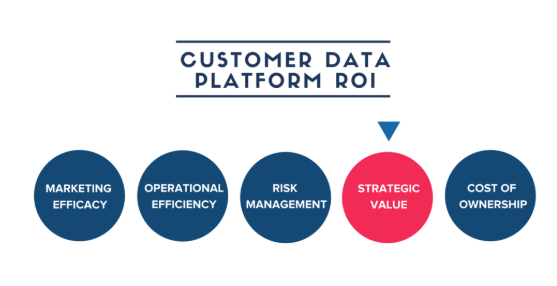
Marketing efficiency and efficacy are important reasons for implementing a customer data platform. But these are tactical concerns, managed by a subset of the business under relatively short time horizons.
Strategic initiatives are, by contrast, stewarded by top management. Their success or failure can be measured by the business’ overall ability to generate high-profit margins relative to competitors and, in turn, the company’s market value.
High-profit margins are evidence of barriers to entry—what every CEO and Board wishes they had more of. As Warren Buffet famously said, the job of good management is to create “economic moats around the castle.” CDPs can help companies build these economic moats by creating demand-side barriers and supply-side competitive advantages.
Demand-side barriers
Demand-side barriers exist when companies have access to market demand that their competitors do not. It is often mistaken for branding; that can be part of it, but anyone can run brand advertising. Much harder to replicate are demand-side barriers created by a customer data advantage. According to research by Columbia University’s Bruce Greenwald, these come in the form of habit, switching costs, and search costs.
Amazon has created a moat around its business by exploiting all three:
- Search costs: You know Amazon will have everything you want at a low price, and you know it will always be easy to find what you want thanks to all the personalization, wish lists, and recommendations. This typically makes it easier to find what you’re looking for on Amazon than anywhere else.
- Habit: Amazon Prime makes it easy to buy again and again without a second thought.
- Switching costs: Amazon saves your preferences and credit card information to make things quick and easy. The more you connect with Amazon—be it through a tablet or a mobile device or your desktop—the harder it becomes to walk away.
What’s remarkable about Amazon is how easily customers could leave Amazon were it not for Amazon’s data advantage. Amazon is keenly aware of this advantage and has continued to it via differentiators like proprietary content and technology hardware in the home. In e-commerce, the next best site is always just a click away. Amazon has organized and applied its customer data to build and meaningful relationship with its audience that cannot easily be replicated.
CDPs can help companies leverage their customer data to create better, “stickier” relationships that lead to a sustained competitive advantage (and high-profit margins) in the long-term.
Supply-side competitive advantage
Supply-side competitive advantages exist when a company has a cost advantage that allows it to produce and deliver products more cheaply than competitors. Customer knowledge—mapped to real identity and underpinned by a customer data platform—can help companies access new markets quicker and faster than competitors.
While the box office has seen studios like Paramount take huge losses in the past year, streaming studios have seen remarkable success. The key difference between Paramount releasing Zoolander 2 and Netflix releasing Bright is that Netflix knows exactly who its customers are and what they watch. Netflix’s content development and purchasing is based on event data including their customers’ viewing choices, when they watch, and how long they watch for, among many other factors. The team at Netflix bases all decisions, from UI to content to pricing on the millions of customer data points they collect. This data-driven approach has enabled Netflix to become one of the biggest producers and distributors of media in the world.
Using a customer data platform can give any company Netflix-like insights they can use to power data-driven decision-making, resulting in cost advantages new entrants can’t easily replicate.
To be clear, some companies land on a business model that has huge network effects and that’s their moat. Facebook and Airbnb are examples of two such companies; they can focus on growth marketing because one user acquired brings tens or hundreds of other users along with them. In that case, the north star is simple: acquire that user, then the next, then the next.
But most businesses don’t enjoy such network effects. To fortify their defenses, and avoid being commodified, brands need to create and invest in the kind of solid data strategy that a CDP can provide.
V. Total cost of ownership
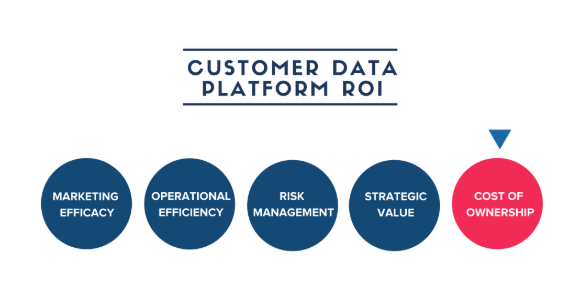
According to a recent survey, it’s estimated that companies in the U.S. and the U.K. lose $140 billion in wasted time, resources, and opportunities due to poor data management. Combine that with increasing costs of MSPs, and you’ve got a serious ROI drain.
To get the most out of your data management, you need to align costs with benefits and determine your total cost of ownership. The final installment of our CDP ROI series breaks down the cost of ownership into four major areas to help you build the last component of your business case: implementation and subscription, maintenance and data enhancement, professional services and training, and security.
Implementation and subscription
The most expensive part of a CDP is the implementation process and the cost of the CDP itself. Unlike other data management solutions, CDPs have a predictable pricing structure so marketers have the option to experiment and customize data integration, reporting, and collection without worrying about receiving an unexpectedly high bill. With more room to experiment, marketers have the liberty to create better, more targeted campaigns to help increase conversions while maintaining a low TCO.
Maintenance and data enhancement
The marketing landscape is always changing, which means that marketers have access to better customer data. But to take advantage of new technology and features from existing partner, brands have to invest time and energy into maintaining their data management practices and platforms.
With the average enterprise company’s stack topping out at 91 tools, that can translate to a lot of engineering time that could otherwise be used to improve customer experience and product development. Using a customer data layer, like a CDP, allows you to have a single point of access for your data, instead of having to integrate SDKs and APIs from each of your integrations. Regardless of your data management solution, you will need to able to collect and connect data from disparate services to be able to target customers effectively and reduce unnecessary spend. The question becomes whether the data management solutions you are considering are able to handle this efficiently without additional custom solutions and without causing your marketing, product, and engineering teams to spend hours wading through the data manually.
Professional services and training
Every solution you put into place is going to have a learning curve for your team, especially as the complexity of a solution increases. While they do take the initial help of professional services (typically provided by the CDP company as a part of your package) to ensure they are properly tooled and will provide secure, accurate access to customer data, CDPs are built to function without the help of engineering.
In fact, many CDPs, mParticle included, have functional UIs that allow for marketers to perform complex data connection, cleansing, and transformation with the click (or drag) of a few components. Audience segmentation, for example, is a case of choosing your parameters, then selecting them as filters, rather than having to run a series of queries to narrow down the scope. In the end, this system allows marketers to react to customer actions in the moment, increasing the likelihood of conversion without adding to the engineering debt. If you want to see an effectiveness lift from multichannel orchestration, for example, you need to factor in the cost of marketing team change management and training. If you are only focused on Integration cost savings you may not need to factor in this cost.
Security costs
As part three of this series states, security is one of the biggest hurdles facing marketers. Achieving and maintaining compliance with the most recent data privacy standards is non-negotiable, especially when you take into account the hefty fines associated with non-compliance. A good CDP is built with data privacy at its core, ensuring that data is encrypted from end-to-end. By implementing a CDP, companies can not only avoid fines from regulations like the GDPR, but also avoid data leaks that can undermine customers’ trust in your brand’s ability to keep their personal data personal.
To understand the ROI a CDP can provide, you need to weigh the costs of implementation and servicing fees against the cost of a potentially catastrophic data breach and fines. GDPR policy dictates that fines can equal up to 4% of global revenue per instance, which can quickly add up.
Conclusion
This series was designed to help you build a better business case for data management, and understand the levers with which to measure and optimize the ROI of the investments you’ve already made. No matter what systems you currently have in place, you should consider the time, risk, and cost involved to determine how it will affect your company’s bottom line. When it comes to data infrastructure investments, carefully considering how it will affect marketing efficacy, operational efficiency, risk management, strategic value, and cost of ownership to determine whether it’s right for your company’s needs. The right tool will help you increase your customer data’s value by making it more actionable, representing an opportunity to optimize the value return. If a CDP seems right for you, feel free to reach out or learn more about them in this in-depth guide.



